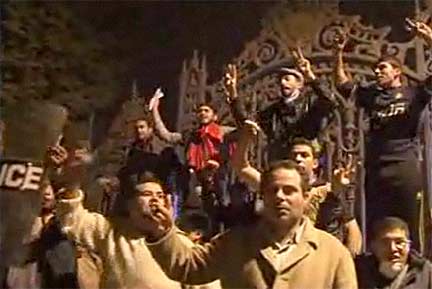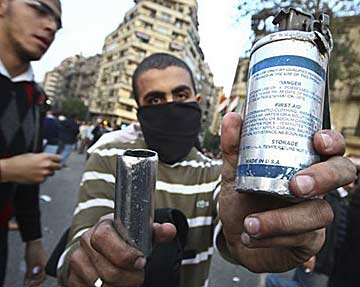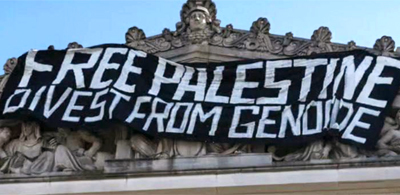The Looting of the Egyptian Museum

Readers of this web log are no doubt aware of events in Egypt, where the people are in open revolt against the U.S.-backed dictator, Hosni Mubarak. The people have but one clear demand, the ousting of Mubarak and the sweeping away of his entire government.
Apart from a few comments, I will mostly leave the political philosophizing and theoretical analysis regarding the situation to others, except to say that I fully support the struggle for democracy currently being waged by the Egyptian people. I salute them for their bravery and their determination to transform their society. U.S. media has generally referred to events in Egypt as a “crisis,” which is far from the truth. What is unfolding is a popular democratic revolution carried out by the Egyptian people. It is only Mubarak and his backers in the White House who face a “crisis”.
As the 30-year old tyrannical regime of Mubarak begins to crumble under popular pressure, chaos reigns on the streets. During the massive protests and fierce police repression of January 28, the downtown Cairo headquarters of Mubarak’s hated political party was torched by furious demonstrators. The neighboring Egyptian Museum seemed in danger from the flames, but more importantly, people wisely thought it might come under attack by opportunistic bandits – and so rushed to defend the institution which houses the treasures of King Tutankhamen as well as the nation’s largest collection of Pharaonic artifacts. As it turned out, nine men did succeed in breaking into the museum by entering through the rooftop. They shattered museum display cases, threw the contents to the ground, and ripped the heads off of two mummies (Correction: the report of beheaded mummies was revealed to be an ugly rumor since proven wholly inaccurate. It turned out to be one of those “sensationalist lies” mentioned in the next paragraph).

The mainstream press has published sensationalist and outlandish lies concerning the looting of the Egyptian Museum. News headlines like “Egyptian protestors ransack Cairo museum,” “Protestors Loot Museum In Cairo,” and “Protestors Destroy Priceless Mummies at Egypt Museum,” are but a few examples of the types of fabrications found in newspapers hostile to the Egyptian people’s fight for democracy. Protestors had nothing to do with the attempted pillaging of the museum; in fact opponents of the Mubarak regime – students, workers, artists, and residents of the neighborhood in which the museum is located, came together to surround the museum with a protective human shield.
The Euronews website posted video footage showing people gathered at the museum gates with the intention of safeguarding the institution from looters. Individual members of the human shield pledged before news reporters that they would not cease guarding the museum until the army came to secure the grounds. The mass of people shown protecting the Egyptian Museum in the video are clearly anti-Mubarak demonstrators; they are chanting slogans and waving the Egyptian flag, one even shows off a police riot shield undoubtedly obtained earlier in the day while clashing with the dreaded security forces.
MSNBC science editor Alan Boyle confirmed that anti-Mubarak demonstrators protected the museum from looters in his MSNBC article, Were Tut’s treasures damaged? Boyle wrote; “(….) young men, some armed with truncheons taken from the police, formed a protective human chain outside the museum’s main gates. ‘I’m standing here to defend and to protect our national treasure,’ one of the men, a 40-year-old engineer named Farid Saad, told AP. AP quoted 26-year-old Ahmed Ibrahim as saying that it was important to guard the museum because it has ‘5,000 years of our history. If they steal it, we’ll never find it again.'”
As the vandals who broke into the museum attempted to exit the building with their loot, they were apprehended by the protestors involved in the human shield as well as by members of the tourism police – a special branch of the police that guard buildings and areas frequented by foreign tourists. The thieves were turned over to the armed forces.
Zahi Hawass, who is recognizable to Westerners because of his role as Egypt’s top archaeologist and the Secretary General of Egypt’s Supreme Council of Antiquities, has filed an interesting report with National Geographic concerning the looting of the Egyptian Museum. Because the criminal Mubarak regime has cut off the internet, making e-mail communications impossible, Mr. Hawass had to file his report by fax to colleagues in Italy, who then uploaded the statement to Hawass’s London website. Hawass acknowledged that young Egyptians protected the museum and helped to apprehend the bandits, he wrote in part:
“What is really beautiful is that not all Egyptians were involved in the looting of the museum. A very small number of people tried to break, steal and rob. Sadly, one criminal voice is louder than one hundred voices of peace. The Egyptian people are calling for freedom, not destruction. When I left the museum on Saturday, I was met outside by many Egyptians, who asked if the museum was safe and what they could do to help (….) Many young Egyptians are in the streets trying to stop the criminals. Due to the circumstances, this behavior is not surprising; criminals and people without a conscience will rob their own country. If the lights went off in New York City, or London, even if only for an hour, criminal behavior will occur. I am very proud that Egyptians want to stop these criminals to protect Egypt and its heritage.”
But who exactly were the men who broke into the Egyptian Museum? They were certainly not anti-Mubarak demonstrators. Perhaps the British journalist Robert Fisk can provide some insight into their true identity, he is currently reporting from Cairo. In his Jan. 29 report for The Independent, A people defies its dictator, and a nation’s future is in the balance, he wrote about the “battagi,” Mubarak’s vicious plainclothes police force. Battagi means “thug” in Arabic, and Fisk observed swarms of battagi at protests “who beat, bashed, and assaulted demonstrators while the cops watched and did nothing.” Fisk witnessed battagi – armed with steel rods, sharpened sticks, and police truncheons – collaborating with Mubarak’s uniformed security forces.
Fisk characterized the battagi as corrupt hooligans, “these men, many of them ex-policemen who are drug addicts, were last night the front line of the Egyptian state – the true representatives of Hosni Mubarak, as uniformed cops showered gas on to the crowds.” In his Jan. 30 report for The Independent, Egypt: Death throes of a dictatorship, Fisk wrote: “there are growing suspicions that much of the looting and arson was carried out by plainclothes cops – including the murder of 11 men in a rural village in the past 24 hours – in an attempt to destroy the integrity of the protesters campaigning to throw Mubarak out of power.” Fisk went on to mention the vandalism at the Egyptian Museum, “Again, it must be added that there were rumours before the discovery that police caused this vandalism before they fled the museum on Friday night.” The Hindu newspaper also reported that “officers from the much despised police force” were held responsible by many Egyptians for the looting of the museum and other buildings.
In addition, National Geographic published an open letter from Ismail Serageldin, the director of the magnificent Bibliotheca Alexandrina, a leading Egyptian library and cultural center located on the Mediterranean coastal city of Alexandria. In that letter titled “To our friends around the world: The Events in Egypt, Mr. Serageldin noted that “lawless bands of thugs, and maybe agents provocateurs,” where responsible for looting, while Egypt’s pro-democracy demonstrators helped to protect the nation’s important cultural institutions. Serageldin’s message was published on the home page of the Bibliotheca Alexandrina website, and I am reprinting his dispatch in full:
To our friends around the world: The Events in Egypt
30 Jan 2011The world has witnessed an unprecedented popular action in the streets of Egypt. Led by Egypt’s youth, with their justified demands for more freedom, more democracy, lower prices for necessities and more employment opportunities. These youths demanded immediate and far-reaching changes. This was met by violent conflicts with the police, who were routed. The army was called in and was welcomed by the demonstrators, but initially their presence was more symbolic than active. Events deteriorated as lawless bands of thugs, and maybe agents provocateurs, appeared and looting began. The young people organized themselves into groups that directed traffic, protected neighborhoods and guarded public buildings of value such as the Egyptian Museum and the Library of Alexandria. They are collaborating with the army. This makeshift arrangement is in place until full public order returns.
The library is safe thanks to Egypt’s youth, whether they be the staff of the Library or the representatives of the demonstrators, who are joining us in guarding the building from potential vandals and looters. I am there daily within the bounds of the curfew hours. However, the Library will be closed to the public for the next few days until the curfew is lifted and events unfold towards an end to the lawlessness and a move towards the resolution of the political issues that triggered the demonstrations.
Ismail Serageldin
Librarian of Alexandria
Director of the Bibliotheca Alexandrina
U.S. Vice President, Joe Biden, was interviewed on the PBS NewsHour on January 27, 2011, where he gave the clearest indication yet of the Obama administration’s view of the uprising against the Mubarak regime. Biden questioned the legitimacy of the uprising while emphasizing Mubarak was not a dictator and should not be forced to resign. Biden urged protesters and government forces to remain non-violent, an absurd appeal since the Obama administration supplies the Mubarak regime with $1.5 billion in military aid a year; machine guns, armored personnel carriers, tanks, helicopters, and fighter jets, much of which are now being deployed against the pro-democracy movement.

On January 28, 2011, WikiLeaks released secret cables sent in 2009 from the U.S. embassy in Cairo to the U.S. State Department in Washington, D.C. The communiqués stated that police brutality in Egypt was “routine and pervasive” and that torture was so widespread the authorities no longer denied it.
One cable said, “NGO contacts estimate there are literally hundreds of torture incidents every day in Cairo police stations alone.” Other secret cables sent to Washington in the past two years revealed that Obama wanted to maintain a close political and military relationship with Mubarak. The same day that WikiLeaks released these damning cables, Obama made a statement to the press that his administration recognizes “the people of Egypt have rights that are universal.” Such appalling deceit! This past week pro-democracy demonstrators in the cities of Cairo, Alexandria, and Suez posed for photographers with empty tear-gas canisters that had been fired at them by police, all of the shells plainly marked, “Made in the U.S.A.” How Egyptians must appreciate Obama’s concern for their universal rights!

On January 29, thousands of Americans and Egyptian expatriates living in the U.S., held rallies in New York City, Washington D.C., Chicago, Los Angeles, San Francisco, Seattle, and other cities to show solidarity with the uprising in Egypt. Demonstrators called upon the Obama administration to cut off all military aid to Mubarak.
I joined the L.A. protest at the Federal Building in Westwood along with around 500 others, most of which were Egyptian-Americans or Egyptians living in exile. My participation in the demonstration was based on my conviction that the historic uprising represents the promise of an actualized global democracy struggled for and won by the world’s people. The White House tells the U.S. citizenry that it is a time of austerity, that government spending on vital social programs must be cut or eliminated, all the while lavishing billions of dollars upon the potentate Mubarak. Enough is enough.
The Mubarak dictatorship has shut down the Al Jazeera bureau in Egypt while simultaneously deploying extra army troops and equipment into big cities; it appears that a full scale military repression may soon be in the offing. On January 30, the Egyptian air force attempted to intimidate protestors by flying multiple passes of their U.S.-supplied fighter jets and helicopters over Tahrir Square in Cairo where tens of thousands of Egyptians have been gathering in their demonstrations against Mubarak. That same day the White House issued a statement calling for “an orderly transition to a government that is responsive to the aspirations of the Egyptian people.” What is actually called for is the immediate suspension of all U.S. military aid to Egypt and a declaration that the despot and his hated cronies resign without delay.
UPDATES – 2/2/1011:
Human Rights Watch emergency director Peter Bouckaert is currently in Egypt. He has reported that several captured looters caught breaking into the Egyptian Museum possessed official police ID cards.
The Egyptian Museum faces further damage. On February 2, thousands of armed pro-Mubarak vigilantes attacked the pro-democracy demonstrators at Tahrir Square, the heart of the Egyptian people’s uprising; the museum sits adjacent to the square. Riding horses and camels the vigilantes assaulted anti-government protestors with whips, iron bars, swords, knives, baseball bats, chains, and other dangerous weapons. At the time of this writing, three demonstrators have been killed and an estimated 1,500 injured. There is little doubt the loyalists are backed and organized by the Mubarak regime, several of the thugs captured by pro-democracy forces were carrying official police ID. Al Jazeera and The Guardian both reported that fighting has intensified around the Egyptian Museum.
The day before the regime’s orchestrated day of violence, Zahi Hawass, the Secretary General of Egypt’s Supreme Council of Antiquities, disgraced himself by accepting a position in Mubarak’s government. The New York Times reported that Hawass accepted the post of Minister of Antiquities, a special cabinet position especially created for him by the dictator. Hawass dishonored himself further by saying Mubarak had responded to the people’s demands, and that the people “should give us the opportunity to change things, and if nothing happens they can march again. But you can’t bring in a new president now, in this time. We need Mubarak to stay and make the transition.” Apparently the beginning of that “transition” was made today with the whips, iron bars, and swords of the goons under Mubarak’s control. Shame on Mr. Hawass.
The perfidious behavior of Zahi Hawass was offset by that of Nouraddin Adbulsamad, the Egyptian Minister of Antiquities. Mr. Adbulsamad was interviewed live on Al Jazeera as the attacks on Tahrir Square were underway. Adbulsamad said the army withdrew from guarding the Egyptian Museum, allowing pro-Mubarak thugs onto the grounds, from there the vigilantes threw rocks and firebombs at the pro-democracy demonstrators in Tahrir Square. Mr. Adbulsamad said the hooligans appeared on the rooftop of the museum, but also seized the rooftops of other buildings from where they hurled Molotov Cocktails at anti-Mubarak protestors. At the time of this post two of these firebombs had landed on the grounds of the Egyptian Museum, setting a tree on fire.
Mr. Adbulsamad called for Mubarak to step down immediately, saying, “Why is the international community silent? (….) “The international community must not just say something – they must do something!” (….) “Mubarak must go, he is a liar, nobody believes a liar” (….) Yes, he must step down, he must leave, this is the first and last solution.” In his emotional interview Mr. Adbulsamad equated Mubarak to the Roman Emperor Nero (54-68 A.D.), who infamously watched Rome burn for nine days. Though he probably had the fires started himself, Nero publicly blamed the Christians, who he then savagely persecuted. Mr. Abdulsamad said Mubarak’s attitude is, “if I don’t stay, I’ll burn down all of Egypt.” Though Mr. Adbulsamad is a government minister, he had the bravery to tell the truth about Hosni Mubarak.



